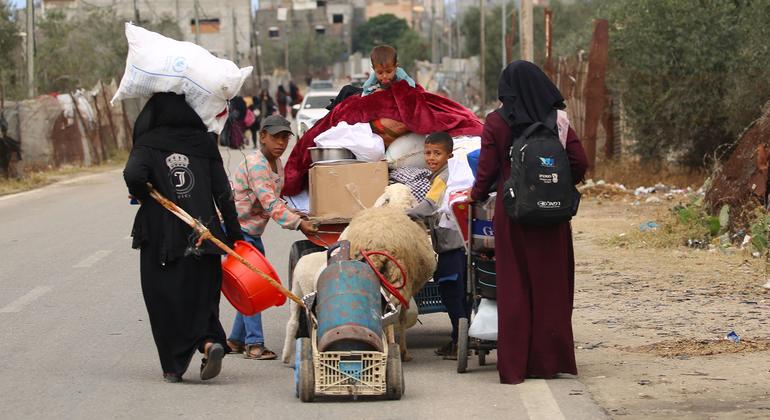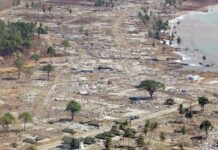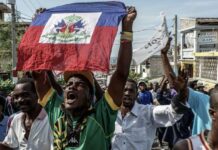“Once again, nearly half of the population of Rafah or 800,000 people are on the road,” Commissioner-General Philippe Lazzarini wrote in post on the social media platform X. formerly Twitter.
He said that following evacuation orders demanding people to flee to so-called safe zones, people mainly went to the middle areas in Gaza and Khan Younis, including to destroyed buildings.
No safe passage or protection
“When people move, they are exposed, without safe passage or protection,” he said. “Every time, they have to start from scratch, all over again.”
Mr. Lazzarini said the areas that people have escaped to do not have safe water supplies or sanitation facilities.
He cited the example of Al-Mawassi, describing it as “a sandy 14 square kilometre agricultural land, where people are left out in the open with little to no buildings or roads.”
The town, located on Gaza’s southern coast, “lacks the minimal conditions to provide emergency humanitarian assistance in a safe and dignified manner.”
He said that more than 400,000 lived in Al-Mawassi before the recent escalation, but now it is “crammed and cannot absorb more people”, which is also the same in Deir al Balah.
‘No place is safe’
“The claim that people in Gaza can move to ‘safe’ or ‘humanitarian’ zones is false. Each time, it puts the lives of civilians at serious risk,” Mr. Lazzarini stated.
“Gaza does not have any safe zones,” he added. “No place is safe. No one is safe.”
The situation is again being made far worse by the lack of aid and basic humanitarian supplies, he continued, noting that humanitarians do not have any more supplies to give out, including food and other basic items.
Meanwhile, key crossings into Gaza remain closed or are unsafe to access as they are located near or in combat zones. Mr. Lazzarini also highlighted the critical need for fuel, which is essential for aid distribution.
Land routes crucial
He said only 33 aid trucks have made it to southern Gaza since 6 May – “a small trickle amid the growing humanitarian needs and mass displacement.”
“While we welcome reports on first shipments arriving at the new floating dock, land routes remain the most viable, effective, efficient and safest aid delivery method,” he said.
Earlier on Saturday, the UN Spokesperson’s Office said the World Food Programme (WFP) confirmed that 10 truckloads of food were transported to its warehouse the previous day via the floating dock, which was installed by the United States military.
“Some of the shipment included high-energy biscuits for WFP to distribute, but there were also commodities for other humanitarian partners to distribute, which included rice, pasta, and lentils,” the note said.
Mr. Lazzarini emphasized that the land crossings into Gaza must re-open and be safe to access. ”Without the re-opening of these routes, the deprivation of assistance and catastrophic humanitarian conditions will persist,” he said.
Ceasefire now
He underlined the obligations of the parties to the conflict, starting with rapid and unimpeded passage of humanitarian relief for all civilians in need, wherever they are located.
“The displaced population must have access to basic survival items, including food, water, and shelter, as well as hygiene, health, assistance and above all safety,” he said.
Humanitarian relief teams also need safe and free movement to access people in need, and protection wherever they may be, and the parties are also obligated to protect civilians and civilian objects everywhere.
“Above all, it is time to agree on a ceasefire,” he concluded.
“Any further escalation in the fighting will only wreak more havoc on civilians and make it impossible to finally have the peace and stability that Israelis and Palestinians desperately need and deserve.”













 English
English French
French Spanish
Spanish German
German Dutch
Dutch Italian
Italian Danish
Danish Portuguese
Portuguese Greek
Greek Russian
Russian Swedish
Swedish Bulgarian
Bulgarian Hungarian
Hungarian Catalan
Catalan Ukrainian
Ukrainian Polish
Polish Basque
Basque Chinese (Simplified)
Chinese (Simplified) Japanese
Japanese Hebrew
Hebrew Arabic
Arabic Swahili
Swahili Amharic
Amharic Irish
Irish Afrikaans
Afrikaans Albanian
Albanian Armenian
Armenian Azerbaijani
Azerbaijani Belarusian
Belarusian Bengali
Bengali Bosnian
Bosnian Cebuano
Cebuano Chichewa
Chichewa Chinese (Traditional)
Chinese (Traditional) Corsican
Corsican Croatian
Croatian Czech
Czech Esperanto
Esperanto Estonian
Estonian Filipino
Filipino Finnish
Finnish Frisian
Frisian Galician
Galician Georgian
Georgian Gujarati
Gujarati Haitian Creole
Haitian Creole Hausa
Hausa Hawaiian
Hawaiian Hindi
Hindi Hmong
Hmong Icelandic
Icelandic Igbo
Igbo Indonesian
Indonesian Javanese
Javanese Kannada
Kannada Kazakh
Kazakh Khmer
Khmer Korean
Korean Kurdish (Kurmanji)
Kurdish (Kurmanji) Kyrgyz
Kyrgyz Lao
Lao Latin
Latin Latvian
Latvian Lithuanian
Lithuanian Luxembourgish
Luxembourgish Macedonian
Macedonian Malagasy
Malagasy Malay
Malay Malayalam
Malayalam Maltese
Maltese Maori
Maori Marathi
Marathi Mongolian
Mongolian Myanmar (Burmese)
Myanmar (Burmese) Nepali
Nepali Norwegian
Norwegian Pashto
Pashto Persian
Persian Punjabi
Punjabi Romanian
Romanian Samoan
Samoan Scottish Gaelic
Scottish Gaelic Serbian
Serbian Sesotho
Sesotho Shona
Shona Sindhi
Sindhi Sinhala
Sinhala Slovak
Slovak Slovenian
Slovenian Somali
Somali Sundanese
Sundanese Tajik
Tajik Tamil
Tamil Telugu
Telugu Thai
Thai Turkish
Turkish Urdu
Urdu Uzbek
Uzbek Vietnamese
Vietnamese Welsh
Welsh Xhosa
Xhosa Yiddish
Yiddish Yoruba
Yoruba Zulu
Zulu